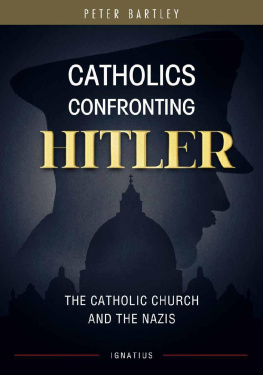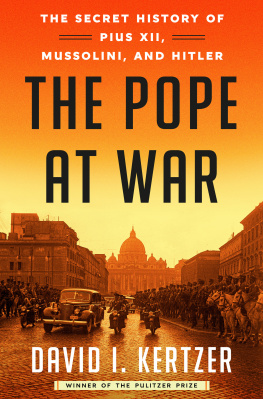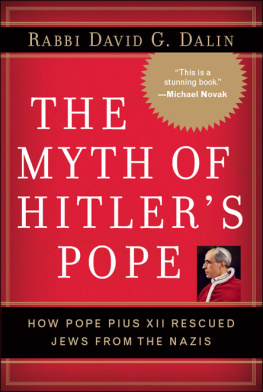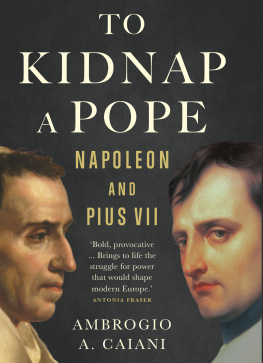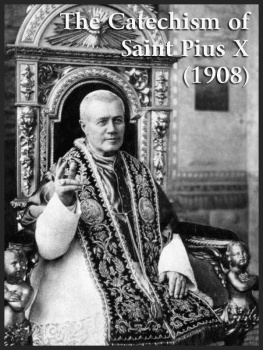CATHOLICS CONFRONTING HITLER
Peter Bartley
CATHOLICS
CONFRONTING
HITLER
The Catholic Church and the Nazis
IGNATIUS PRESS SAN FRANCISCO
Cover design by Enrique Javier Aguilar Pinto
2016 by Ignatius Press, San Francisco
All rights reserved
ISBN 978-1-62164-058-5 (PB)
ISBN 978-1-68149-729-7 (EB)
Library of Congress Control Number 2015948575
Printed in the United States of America
CONTENTS
INTRODUCTION
Hitlers Rise to Power19191933
By 1918, four years of trench warfare had left Germany exhausted and her army facing defeat. Field Marshal Paul von Hindenburgs final offensive in the West had failed, and with American troops pouring into France to reinforce the Allies, he and his chief of staff, General Erich Ludendorff, accepted the inevitable and sued for peace. On 11 November, an armistice was signed between Germany and the Allied Powers at Compiegne in Northeast France, bringing the First World War to an end. Recovering from temporary blindness in a military hospital in Pomerania, Corporal Adolf Hitler heard the news of the German surrender and wept.
Following the emperors abdication, a German republic was proclaimed with the Social Democrat Friedrich Ebert as president. In the German town of Weimar on the river Elbe, a newly formed coalition government, composed mostly of Social Democrats and Catholic Centre Party members, approved the peace terms that had been dictated by the Allies at Versailles a few weeks before. These events left not only Hitler but also a great many Germans feeling disillusioned and embittered.
A social misfit and sometime vagrant in prewar Vienna, Hitler had served with distinction when war came, earning the highest military decorations his country could bestow. For a brief time after the armistice, he remained in the army, where he was given political training and assigned to educational duties. In the revolutionary atmosphere of 1919, Hitler was sent to Munich by army intelligence to report on a small left-wing group known as the German Workers Party (DAP), which had been cofounded in January of that year by Anton Drexler, a toolmaker and labour activist, and Karl Harrer, a journalist. To begin with, the DAP was little more than a debating club, until Drexler raised its political profile and its reputation among those on the fringe of the political spectrum. Embracing a socialist ideology fused with nationalism, xenophobia, and anti-Semitism, the group made an immediate impression on Hitler, whose own ideological development had already taken shape along similar lines. In September 1919, Hitler joined the party. The following year, he changed its name to the National Socialist German Workers Party, shortly to be abbreviated to Nazi. By 1921, Hitler had wrested control of the party from Drexler.
The party programme was drawn up by Hitler, Drexler, and Gottfried Feder (the groups economics adviser) in February 1920. Its twenty-five principles included the nationalisation of industries on a limited scale and the reform of land ownership. Especially noteworthy was point 24 of the programme, which promised religious freedom, except for religions which endanger the German race, which could be interpreted to mean almost any religion and did, in fact, portend the dilution of Christianity in the interests of race theory. The programme stressed a preference for Positive Christianity, without prejudice to denominational interests.
When Hitler joined the party, it had fewer than fifty members. By January 1921, the membership had risen to three thousand, and the party had extended its sphere of influence beyond Munich to the rest of Bavaria. Hitler made the difference. Having discovered a flair for a firebrand style of oratory that played upon his listeners fears and their distrust of Weimar politicians, Hitler drew thousands to his political meetings in the beer cellars of postwar Munich. In impassioned, vituperative tirades, he castigated the enemies of the Fatherlandthe capitalists, the Bolsheviks, the traitorous politicians who had stabbed the German people in the back, and, above all, the Jews, this mortal enemy of our nation and of all Aryan humanity and culture.
The year 1923 was a disastrous one for the German economy, and for Hitler also, despite a great upsurge in support for his party. With the economy on the point of collapse, the country was unable to pay the war reparations required under the Treaty of Versailles. In an ill-conceived attempt to enforce payment, the French occupied the Ruhr, Germanys industrial heartland on the west bank of the Rhine. In November, Hitler and Ludendorff conspired to topple the Bavarian government in Munich. The operation, planned in a beer hall, was a botched affair with no hope of success, and the police had little difficulty routing the insurgents. Hitler, Ludendorff, and other leading Nazis were arrested and the SA and the Nazi Party outlawed. Receiving a term of five years imprisonment for his part in the affair, Hitler was sent to Landsberg Prison to complete his sentence. For the nine months of the sentence that he actually served, he was treated indulgently by a fawning prison staff. He received a stream of admiring visitors, posed for photographs, and occupied his time dictating the first volume of his political testament, Mein Kampf , to his disciple and collaborator Rudolf Hess before his early release in December 1924.
Albert Speer, Hitlers armaments minister, confessed that he had abandoned the effort to read Mein Kampf . Goebbels, on the other hand, thought it wonderful and was lavish in his praise of Hitlers political instinct. Crude, turgid, and half-baked are some of the less-than-complimentary judgements that have been passed upon the book. Where Jews were concerned, ambiguity was not one of its defects; Jews and Bolsheviks alike were hated by Hitler, who made no distinction between the two. Hitlers anti-Semitism had its origin in late-nineteenth-century race theory, especially that which elevated the status of German culture and ascribed to Germans the dominant role in Europe. A special feature of the theory was its emphasis on the purity of German blood.
Exactly when Hitler became an anti-Semite is uncertain. Before his Vienna days, he had read with approval the prose of the composer Richard Wagner, a noted anti-Semite. As a young man in Vienna, he was an admirer of Karl Lueger, the citys anti-Semitic, though popular, mayor. However, a recent biographer, Ian Kershaw, has noted that Hitler showed few signs of anti-Semitism in his Vienna days and that he had several Jewish acquaintances, a fact also alluded to by Hitlers first biographer, Konrad Heiden. By the end of his time in the Austrian capital, Hitlers ideological outlook seems to have been well formed; it then became hardened as a result of his experience of war. By the time he met Drexler in Munich in 1919, Hitler was a political extremist and an undoubted anti-Semite.
Hitler classified Jews negatively: they were non-Aryans, and when describing them he used the language of pathology. Jews were a dangerous admixture; they polluted the German race. Jews, said Hitler, were spiritual pestilence, worse than the Black Death of olden times. Jews were, on the other hand, prominent among the supporters of Italian Fascism.
Hitler, the obsessive anti-Semite, saw Jews behind everything he abominated. Thus, it was impossible for them to escape the odium that was heaped upon them. So the Jews were damned for being capitalists, and they were damned for being Communists. It was held against them that they were overrepresented in the professions and also that they were an inferior race. The Weimar culture that Hitler and the Nazis so despised hardly extended beyond big cities such as Berlin and Hamburg, but the cosmopolitan Jew came to personify in their view every vice of the republic.
Next page
